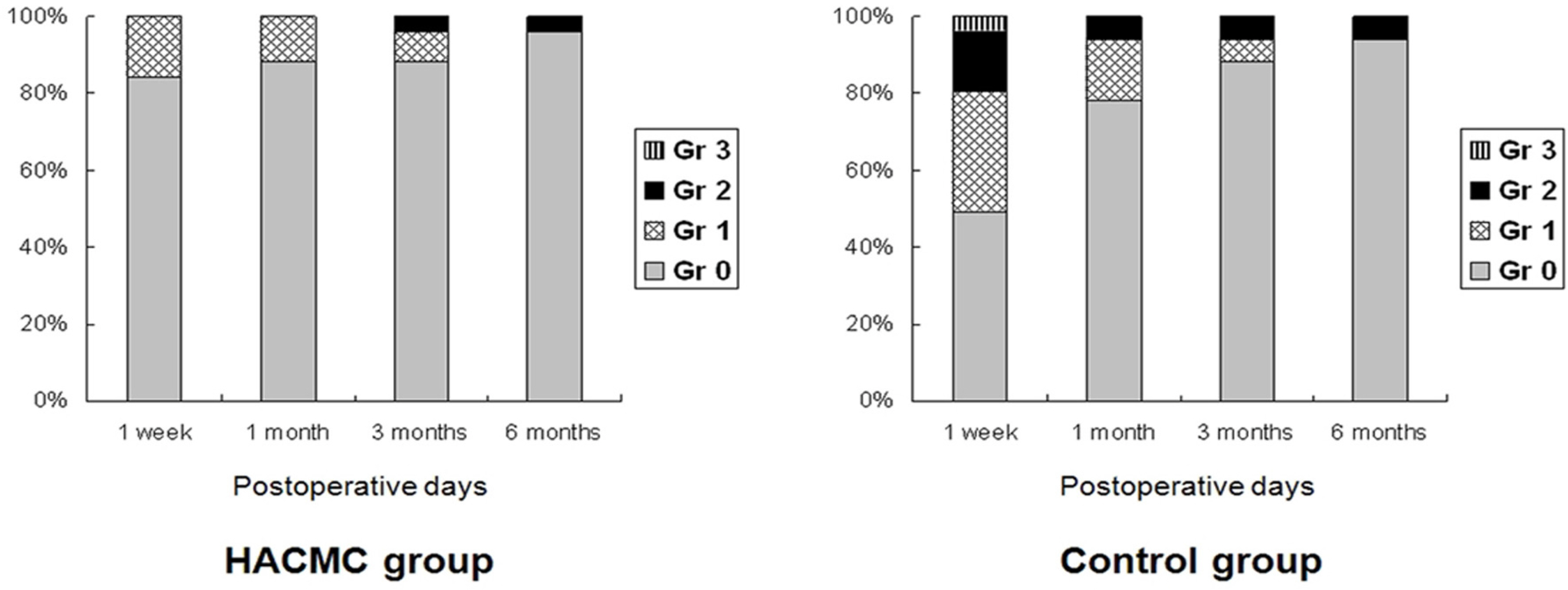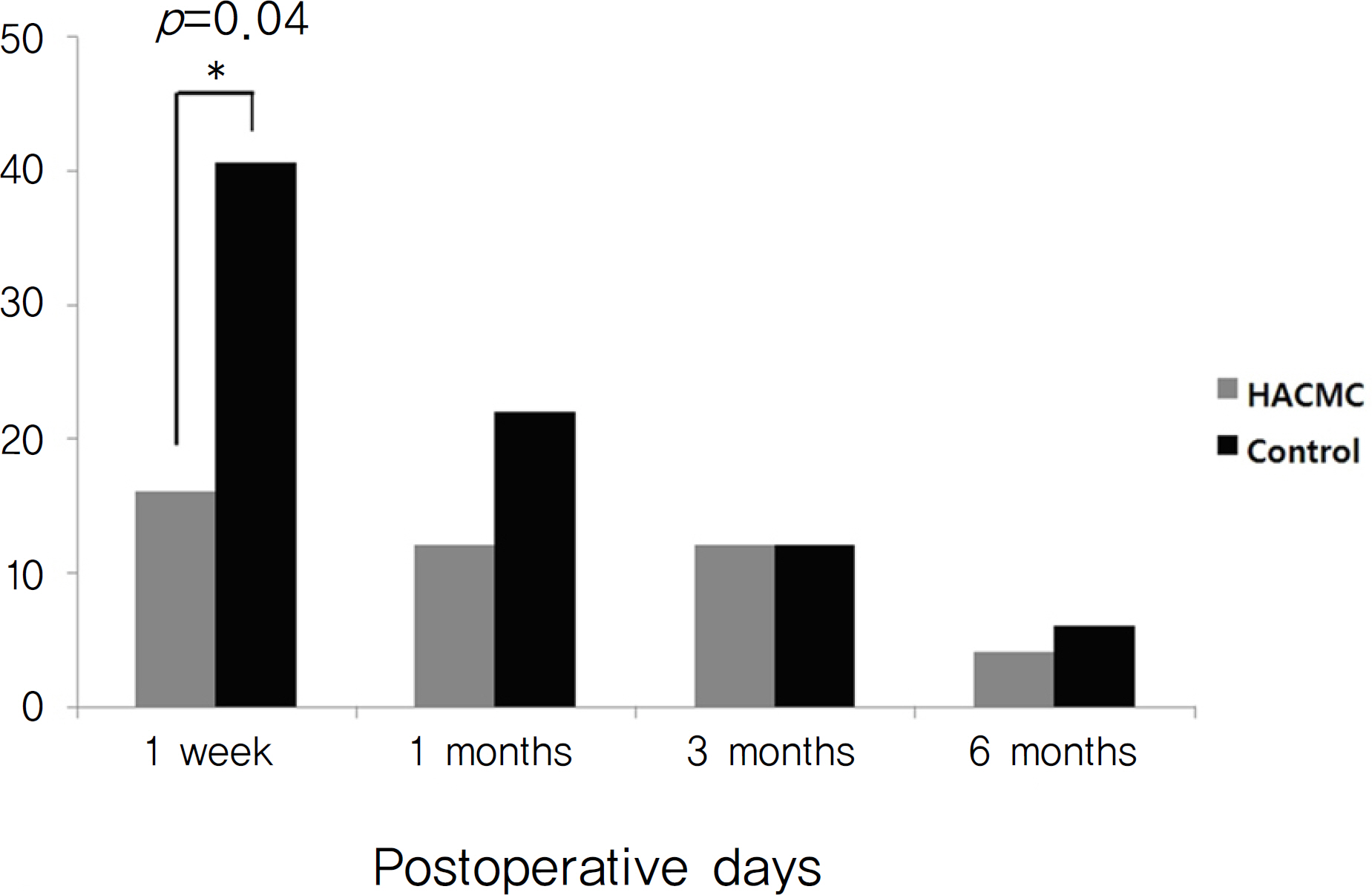J Korean Ophthalmol Soc.
2010 Jun;51(6):795-801. 10.3341/jkos.2010.51.6.795.
Clinical Effect of the Mixed Solution of Sodium Hyaluronate and Sodium Carboxymethylcellulose After Endonasal Dacryocystorhinostomy
- Affiliations
-
- 1Department of Ophthalmology, Chonnam National University Medical school and Hospital, Gwangju, Korea. kcyoon@chonnam.ac.kr
- KMID: 2213598
- DOI: http://doi.org/10.3341/jkos.2010.51.6.795
Abstract
- PURPOSE
To evaluate the effects of a mixed solution of sodium hyaluronate and sodium carboxymethylcellulose (HACMC, Guardix-sol(R)) for reducing postoperative adhesion after endonasal dacryocystorhinostomy.
METHODS
Endonasal dacryocystorhinostomy was performed on 58 patients with obstructions of the nasolacrimal system. We divided the 58 patients into two groups. At the completion of endonasal dacryocystorhinostomy, HACMC was applied to the operative site in the experimental group (n=26) and normal saline was applied in the control group (n=32). For the evaluation of clinical effectsand postoperative adhesion, subjective symptom score evaluations, lacrimal irrigation tests, fluorescein disappearance tests, and endoscopic examinations were performed at 1 week, 1 month, 3 months, and 6 months postoperatively.
RESULTS
The HACMC-treated patients showed better results than the control patients for subjective symptom scores, lacrimal irrigation tests, and fluorescein disappearance tests, but these differences were not statistically significant. Upon endoscopic examination, the HACMC group revealed lower incidence of adhesion at 1 week after surgery and lower severity of adhesion throughout the period of observation (p<0.05).
CONCLUSIONS
The application of a mixed solution of HACMC may effectively reduce postoperative adhesion after endonasal dacryocystorhinostomy.
MeSH Terms
Figure
Cited by 2 articles
-
Clinical Effect of a Mixed Solution of Sodium Hyaluronate and Sodium Carboxymethylcellulose During the Transconjunctival Approach for Orbital Wall Reconstruction
Byung Wan Kang, Hyo Seok Lee, Han Jin Oh, Kyung Chul Yoon
Chonnam Med J. 2012;48(2):123-127. doi: 10.4068/cmj.2012.48.2.123.The Clinical Effects of Triamcinolone-soaked Nasal Packing on Endonasal Dacryocystorhinostomy
Seok Hyeon Song, Ka Hyun Lee
J Korean Ophthalmol Soc. 2018;59(4):307-313. doi: 10.3341/jkos.2018.59.4.307.
Reference
-
References
1. Toti A. Nuovo metodo conservatore dicuraradicale delle sopourazioni croniche delsaccolacrimale (dacriocistorhinostomia). Clin Moderna. 1904; 10:385–7.2. Caldwell GW. Two new operations for obstruction of the nasal duct with preservation of the canaliculi. Am J Ophthalmol. 1893; 10:189.3. McDonogh M, Meiring JH. Endoscopic transnasal dacryocystorhinostomy. J Laryngol Otol. 1989; 103:585–7.
Article4. Boush GA, Lemke BN, Dortzbach RK. Results of endonsal laser assisted dacryocystorhinosotmy. Ophthalmology. 1994; 101:955–9.5. Woog JJ, Meston R, Puliafito CA. Holmium; YAG endonasal laser dacryocystorhionostomy. Am J Ophthalmol. 1993; 116:1–10.6. Metson R. Endoscopic surgery for lacrimal obstruction. Otolaryngol Head Neck Surg. 1991; 104:473–9.
Article7. Lee HC, Chung WS. Success rate of endonasal dacryocystorhinostomy. J Korean Ophthalmol Soc. 1996; 37:211–8.8. Goldberg RA. Endonasal dacryocystorhinostomy: is it really less successful? Arch Ophthalmol. 2004; 122:108–10.9. Mannor GE, Millman AL. The prognostic value of preoperative dacryocystography in endoscopic intranasal dacryocystorhinostomy. Am J Ophthalmol. 1992; 113:134–7.
Article10. Park JD, Kim YI, Shin SG. The factors related to surgical success rate of endonasal dacryocystorhinostomy. J Korean Ophthalmol Soc. 1998; 38:2848–53.11. Lee DP, Yang SW, Choi WC. The relation between nasal cavity size and success rate in endonasal dacryocystorhinostomy. J Korean Ophthalmol Soc. 2000; 41:1118–23.12. Kao SC, Laio CL, Tseng JH, et al. Dacryocystorhinostomy with intraoperative mitomycin C. Ophthalmology. 1997; 104:86–91.
Article13. Ramadan HH. Surgical causes of failure in endoscopic sinus surgery. Laryngoscope. 1999; 109:27–9.
Article14. Chung JH, Cosenza MJ, Rahbar R, Metson RB. Mitomcycin C for the prevention of adhesion formation after endoscopic sinus surgery: A randomized, controlled study. Otolaryngol Head Neck Surg. 2002; 126:468–74.15. Jin HR, Shin SO, Choi YS, et al. Endoscopic endonasal dacryocystorhinostomy: prevention of noeostium obstruction using nasal mucosal flap. Korean J Otolaryngol – Head Neck Surg. 2003; 46:1040–5.16. Lee TS, Kim SW, Park BW. The relationship between rate of wound healing and success rate after endonasal laser-drill assisted dacryocystorhinostomy. J Korean Ophtahalmol Soc. 1999; 40:2969–74.17. Choi YJ, Hwang SJ, Lee TS. Short-term clinical results of amniotic membrane application to endonasal dacryocystorhinostomy. J Korean Ophthalmol Soc. 2008; 49:384–9.
Article18. Beck DE, Cohen Z, Fleshman JW, et al. A prospective, randomized, multicenter, controlled study of the safety of Seprafilm adhesion barrier in abdominopelvic surgery of the intestine. Dis Colon Rectum. 2003; 46:1310–9.
Article19. Kelekci S, Uygur D, Yilmaz B, et al. Comparison of human amniotic membrane and hyaluronate/carboxymethylcellulose membrane for prevention of adhesion formation in rats. Arch Gynecol Obstet. 2007; 276:355–9.
Article20. Naito Y, Shin’oka T, Hibino N, et al. A novel method to reduce pericardial adhesion: a combination technique with hyaluronic acid biocompatible membrane. J Thorac Cardiovasc Surg. 2008; 135:850–6.
Article21. Yaacobi Y, Hamed LM, Kaul KS, Fanous MM. Reduction of postoperative adhesions secondary to strabismus surgery in rabbits. Ophthalmic Surg. 1992; 23:123–8.
Article22. Ozkan SB, Kir E, Culhaci N, Dayanir V. The effect of Seprafilm on adhesions in strabismus surgeryan experimental study. J AAPOS. 2004; 8:46–9.23. Kwon SW, Seo YW, Cho YA, et al. Antiadhesive effect of the mixed solution of hyaluronate and sodium carboxymethylcellulose after strabismus surgery. J Korean Ophthalmol Soc. 2009; 50:145–50.
Article24. Taban M, Nakra T, Mancini R, et al. Orbital wall fracture repair using seprafilm. Ophthal Plast Reconstr Surg. 2009; 25:211–4.
Article25. Linberg JV, Anderson RL, Bumsted RM, Barreras R. Study of intranasal ostium external dacryocystorhinostomy. Arch Ophthalmol. 1982; 100:1758–62.
Article26. Iliff CE. A Simplified dacryocystorhinostomy. Arch Ophthalmol. 1971; 85:586–91.
Article27. Lee TS, Kim JS, Kim JK. The effect of double silicone tube intubation on surgical outcome of endonasal dacryocystorhinostomy. J Korean Ophthalmol Soc. 2002; 43:2089–94.28. Kim SJ, Kim SD. The surgical result of endonasal DCR with two silicone tubes in common canalicular obstruction. J Korean Ophthalmol Soc. 2007; 48:1170–6.29. Yeatts RP, Neves RB. Use of mitomycin C in repeat dacryocystorhinostomy. Ophthalmic Plast Reconstr Surg. 1999; 15:19–22.
Article30. Rhee KC, Lee TS. The effect of mitomycin-C eyedrop on prevention of internal ostium obstruction after endonasal dacryocystorhinostomy. J Korean Ophthalmol Soc. 1998; 49:2923–7.31. Kim YT, Chung WS. The effect of mitomycin C in endonasal dacryocystorhinostomy. J Korean Ophthalmol Soc. 2002; 43:728–32.32. Hellebrekers BW, Trimbos-Kemper TC, Trimbos JB, et al. Use of fibrinolytic agents in the prevention of postoperative adhesion formation. Fertil Steril. 2000; 74:203–12.
Article33. Gago LA, Saed GM, Chauhan S, et al. Seprafilm (modified hyaluronic acid and carboxymethyl cellulose) acts as a physical barrier. Fertil Steril. 2003; 80:612–6.34. Oncel M, Remzi FH, Senagore AJ, et al. Comparison of a novel liquid (adcon-P®) and sodium hyaluronate and carboxymethylcellulose membrane (SeprafilmTM) in postsurgical adhesion formation in a murine model. Dis Colon Rectum. 2003; 46:187–91.
- Full Text Links
- Actions
-
Cited
- CITED
-
- Close
- Share
- Similar articles
-
- Results of the Mixed Solution of Hyaluronate and Sodium Carboxymethylcellulose in Endonasal Dacryocystorhinostomy
- Antiadhesive Effect of the Mixed Solution of Hyaluronate and Sodium Carboxymethylcellulose After Strabismus Surgery
- Clinical Effect of a Mixed Solution of Sodium Hyaluronate and Sodium Carboxymethylcellulose During the Transconjunctival Approach for Orbital Wall Reconstruction
- Clinical Results of Anti-adhesion Adjuvants after Endonasal Dacryocystorhinostomy
- The Effect of Hyaluronate-Carboxymethyl Cellulose on Bone Graft Substitute Healing in a Rat Spinal Fusion Model




